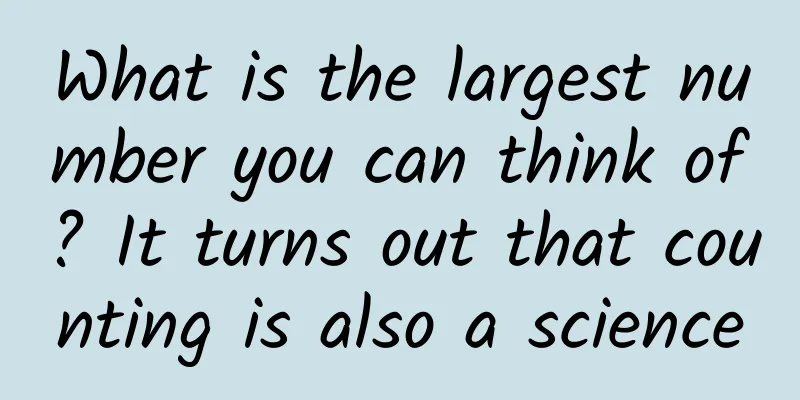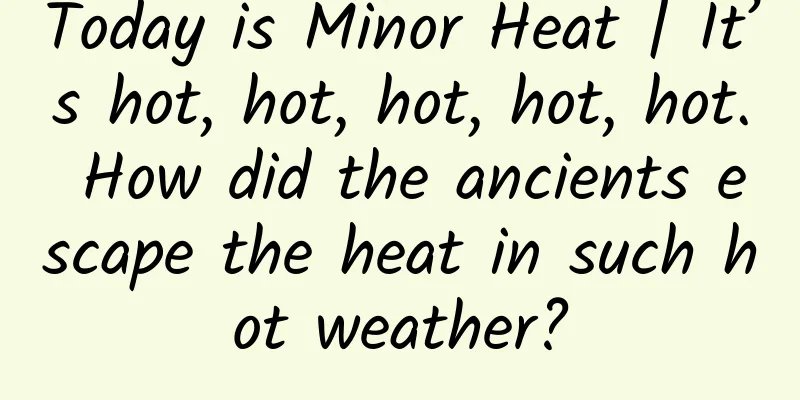What is the largest number you can think of? It turns out that counting is also a science

|
Ask a child what the largest number he can think of is, and he will often rattle off "fifty trillion ... Such numbers are certainly large by everyday standards, perhaps larger than the number of all living things on Earth or the number of stars in the universe. But they pale in comparison to the truly big numbers that mathematicians encounter. "Googology" is a sub-discipline that specializes in the study of huge numbers ( please note that it is "googology", not "googology" ). A few years ago, MIT held a "Big Numbers Championship". The rules are simple, two people go to the blackboard and take turns writing a number, and the one with the bigger number wins. There are some restrictions, like you can't write "the other person's number + 1" or infinity, but for the most part, as long as the numbers are clearly defined, you can write whatever you want. The poster of the "Big Numbers Championship" shows the champion Rayo on the lower left. Remember this person, as you will be asked later. So, how come counting has become a science and even a competition? 01 The first brain to think about big numbers Archimedes is considered one of the first people to seriously think about large numbers. He wanted to know how many grains of sand there were in the world, and how many grains of sand could fit into all of space. In his essay “The Counting Man of Sand,” he wrote: I know some people think that the number of grains of sand is infinite... but there are others who don't think that the number of grains of sand is infinite, but think that there is no number that can exceed it. To pave the way, Archimedes began to expand the naming system for large numbers available at the time—a key challenge that all mathematicians who have since tried to define larger and larger integers have encountered. The Greeks called 10,000 murious , which means " uncountable ." Archimedes used "murious" as the starting point for his research, which is 100,000,000, which is 108 in modern exponents. Archimedes called any number that reaches "infinitely infinite" a " first-order number ", and the number that reaches "infinitely infinite" multiplied by "infinitely infinite" (1016) a " second-order number ", and so on. In this way, Archimedes could describe numbers with 800,000,000 digits, which he defined as the " first stage ". The number 10800000000 itself was regarded as the beginning of the " second stage ", and the process continued to restart. Each stage was 108 times larger than the number in the previous stage, until the end of countless cycles, and finally, he could get a huge number. 1080,000,000,000,000,000, or an “ infinitely many times an infinite number of times an infinite number of times .” 02 Mysterious oriental power As far as large numbers are concerned, Archimedes can be regarded as a wizard in the Western world, but in the Eastern world, scholars soon made great progress in the exploration of large numbers. As early as around the 3rd century, the Indian Sanskrit text the Prasanna Sutra introduced a number system that began with koti (10,000,000 in Sanskrit). From the koti on down came a long string of numbers, each one a hundred times greater than the last: a hundred kotis were an ayuta , a hundred ayutas were a niyuta, all the way to tallakshana , or 1 followed by 53 zeros. Meanwhile, he named still larger numbers dhvajhagravati, equal to 1,099, up to uttaraparamuarajapravesa, or 10,421. Another Buddhist text, the Avatamsaka Sutra, describes a universe with infinite layers and intersecting layers. In Book 30, the Buddha again expounds on the formation of large numbers, starting with 1010, squaring it to get 1020, squaring it again to get 1040, and so on to 10101 493 392 610 318 652 755 325 638 410 240. Square this number again and you get " the innumerable ". He goes on to name larger numbers "immeasurable", "boundless", "incomparable", "innumerable", "inconceivable", "immeasurable", "ineffable", and finally culminates in an " ineffable and ineffable " number - 1010×(2^122). This number dwarfs the largest number mentioned in Archimedes's writings, 1080 000 000 000 000 000. 03 The universe can no longer contain huge numbers In 1920, American mathematician Edward Kasner asked his nine-year-old nephew Milton Sirota to come up with a name for the number 1 followed by 100 zeros, and Sirota came up with " googol ". After being cited in Kasner's and James Newman's book "Mathematics and the Imagination", "googol" entered the popular lexicon. Sirota also coined the term " googolplex ," which means "write 0s after 1 until you get tired." If we refine this understatement, a googolplex can be expressed precisely as follows: it is 10 googols, or 1 followed by googol 0s. A googolplex is so large that there is not enough paper on Earth to write it down, and even if each zero is written as small as a proton or electron, there would not be enough digits in the entire observable universe to write down all of its digits. "There is not enough paper in the known universe to write all the zeros in a googolplex." The values of googolplex, zoogol and zoogolplex derived from googol The googolplex is larger than any number with a name in ancient times, including the "unspeakable unspeakable rotation". However, it is smaller than a number - the " Skeeves number ". It was created by South African mathematician Stanley Skewes in 1933 when studying prime numbers. It refers to the upper limit of the prime number distribution problem, and the value is 1010^8852142197543270606106100452735038.55. The famous British mathematician Godfrey Harold Hardy described the "Skeeves number" as " the largest number with any practical significance in the history of mathematics ", and this huge upper limit itself requires the Riemann hypothesis. Not to be outdone by pure mathematics, physicists have come up with some big numbers in physics to solve unusual problems. An early player in this battle of big numbers on the frontier of physics was French mathematician, theoretical physicist, and polymath Henri Poincare . In his many works, he asked a question: How long does it take for a physical system to return to a certain state exactly? This time is called the " recurrence time ." Canadian theorist Don Page (a former student of Stephen Hawking) estimates that the Poincare recurrence time for the observable universe is 1010^10^10^2.08 years, which is between the googolplex and the Skives number. 04 New symbols? New spells! When exponential symbols were too frequent and not conducive to typesetting, American computer scientist Donald Knuth introduced the " upward arrow notation ". In this nomenclature, exponential operations are represented by a single upward arrow ↑ , such as googol (10100) can be represented as 10↑100, and 33 can be represented as 3↑3. Repeated exponential operations (for which we do not have everyday symbols) are represented by two upward arrows ↑↑, which are called " iterative powers ". This operation is very intensive. Take the small number 3 as an example: 3↑↑3=33^3 =327 Its value is: 7,625,597,484,987 Going from exponential to iterative power, we just added an upward arrow, which led to a more dramatic increase. If we continued like this, the length of this power tower would stretch to the sun. This number is called tritri , and it is far larger than any number we have mentioned so far, and it is simply beyond the scope of our mortal beings. But we are just getting started . As huge as tritri is, it is still a tiny speck of dust compared to the great peak of Graham's number . Ronald Graham Mathematician, acrobat, magician A true "slash person" His wife is Jin Fangrong, a Chinese graph theory expert. Therefore, he also took the Chinese name "Ge Liheng" Let's add an upward arrow to the number we just saw, and we can see: 3↑↑↑↑3=3↑↑https://pqnoss..cn↑↑3=3↑↑↑tritri . The first level is 3 . The second layer is 3https://pqnoss..cn3=7,625,597,484,987 . The third layer is 3https://pqnoss..cn3↑3…↑3——that is, there are 7,625,597,484,987 3s (that is, tritri) . The fourth layer is 3https://pqnoss..cn3↑3…↑3, which is tritri 3 . By analogy, 3↑↑↑↑3 is the power tower of tritri. ↑↑↑, this is an incredibly huge improvement. But so far, we have only climbed to G1 , the first of the Graham numbers, the starting point of the Graham numbers themselves. What is G2? 3↑↑↑↑…↑3, G1 upward arrows. Even just looking at it, this number is a bit dizzying. We can continue to speculate that G3 will have G2 upward arrows, and G4 will have G3 upward arrows... and how big is the Graham number? It is G64 . And it is still not the largest number that humans can create at present. 05 “Theoretical numbers” Remember the big numbers showdown at the beginning? This math battle, which is a mixture of comedy, complex mathematics, logic, and philosophical speculation, is full of drama and entertainment. The champion is MIT philosopher Agustín Rayo (nicknamed "Mexican Proliferation Monster"), and the challenger is Princeton University philosopher Adam Elgar (nicknamed "Dr. Evil"), and the two are competing to see who can define a larger integer. Elgar started with the number 1, but Rayo quickly countered by covering the entire board with 1s. Not to be outdone, Elgar immediately erased all but the first two 1s, turning it into 11 followed by a series of factorial signs (!). It does fall under the fair use rule As these duels continued, numbers eventually expanded beyond the realm of familiar mathematics, until the opponents were forced to invent their own symbols to represent larger numbers. Finally, Rayo delivered the coup de grace by describing this number as " the smallest positive integer greater than any finite positive integer named by any symbol expressed in the language of first-order set theory, including the googol symbol or less. " Just how big this Layo number is, we have no way of knowing, and we may never know. There is not enough time and space: Layo's number is uncomputable, just as the halting problem is uncomputable . Now, when it comes to the largest positive integers that we can easily perceive, Rayo numbers more or less mark the boundary between what we know and what we don't know. Some larger numbers have been created, the most famous of which is " BIG FOOT ", which was created in 2014. But to get a glimpse of BIG FOOT means entering a strange place called " oodleverse " and learning the language of "first-order oodle theory" - a great adventure that requires us to have a higher level of mathematics and a higher level of humor to solve. After all, all the largest named numbers that have been achieved so far are based on the same system of Layo numbers. It’s easy to think that huge numbers like Lajos’ numbers bring us closer to infinity. But that’s not the case. Infinite numbers may be used to generate finite numbers, but no matter how high we find them, there’s never a point where the finite and the infinite merge. In fact, finding larger finite numbers doesn’t bring us any closer to infinity than we did when we counted 1, 2, 3 as children. But we always end up somewhere with a larger radius. ——Interaction issues—— What is the biggest number you can imagine? Welcome to share in the comment section~ |
>>: Dragonflies, the flying kings of nature, why can we no longer see them flying in the sky?
Recommend
Why is the Chinese version of the 16G gold iPhone 6 Plus the best choice?
Even though it has been released for more than tw...
The car industry's king of running points, the Roewe i6, tells you more than just the Internet
The Roewe i6 had already received a lot of attent...
Can the dog that has completed the experiment be happy if it is adopted?
Recently, a celebrity couple adopted a beagle and...
Luckin Coffee community operation skills!
After Luckin Coffee was suspended and delisted, i...
Xiaohongshu KOL operation strategy from 1 to 100!
Introduction Users' following, comments, unfo...
Why did the three major IPs - "Tiny Times", "Old Boy" and "Boonie Bears" all find LeTV and successfully cross over?
As a winner of Toutiao's Qingyun Plan and Bai...
The last source of animal protein for humans! The quantity is as high as hundreds of millions of tons, why hasn’t it become a national delicacy?
Expert of this article: Liu Yadan, former assista...
Look at this fish, it is so "dog" and so fragrant
The protagonist of today’s article is fish, a typ...
Apple has sent out invitations to its new product launch event in October 2014. It’s been a long time since we last saw it!
Apple officially sent out invitations to the medi...
The "best lifestyle" for longevity, these 4 factors are the key!
Compiled by: Gong Zixin We know that genetics and...
These 7 trends may be the key to e-commerce user experience design in 2017!
Immersive experience, virtual assistants, persona...
All the creative routines for high-click information flow in the 4 major industries are here!
As we all know, due to its own industry attribute...
Advertising case in wedding photography industry!
During the epidemic, the wedding photography indu...
Deliciousness and virtue coexist, the ancients' "chicken on the tip of the tongue" actually has so many meanings!
my country is one of the earliest countries to do...
How can I convert and monetize the user if I don’t have a strong relationship with him?
A reader asked this question. I think this questi...









